Memorandum - Joint Steering Committee for Development of RDA
Memorandum - Joint Steering Committee for Development of RDA
Memorandum - Joint Steering Committee for Development of RDA
You also want an ePaper? Increase the reach of your titles
YUMPU automatically turns print PDFs into web optimized ePapers that Google loves.
UNITED STATES GOVERNMENT<strong>Memorandum</strong>LIBRARY OF CONGRESS5JSC/<strong>RDA</strong>/Part A/Categorization/LC responseTO: <strong>Joint</strong> <strong>Steering</strong> <strong>Committee</strong> <strong>for</strong> Revision <strong>of</strong> AACR DATE: Sept. 18, 2006FROM:SUBJECT:Barbara B. Tillett, LC RepresentativeCategorization <strong>of</strong> content and carrierGeneral CommentsAlthough the Library <strong>of</strong> Congress appreciates the categorization analysis documented inthe <strong>RDA</strong>/ONIX Framework <strong>for</strong> Resource Categorization, after discussion here, includingwith our graphic cataloguing experts, we feel that the current ef<strong>for</strong>t suffers in a few keyareas:1. Missing objective: “Intelligibility”, that is, terms that are intelligible to catalogueusers. This was one <strong>of</strong> the <strong>for</strong>emost objectives in the work <strong>of</strong> the GMD/SMD WorkingGroup (see section 3.1 in their report), but we feel that not enough emphasis on thisobjective is obvious in this categorization exercise. This flaw is most evident in thecarrier term list. Although we can follow how a “pure” modeling exercise may haveresulted in the proposed list, we also recognize (as the GMD/SMD Working Group did)that it is too difficult in some cases to separate content and carrier, or carrier and media,and be left with terms that would be recognized by catalogue users. The recent AACR2progress towards including “terms in common usage”-- which we expected to seeadvanced in this draft-- seems to have halted.2. Unbalanced “comprehensiveness”: there is an overemphasis on many outdated<strong>for</strong>mats unlikely to be encountered by cataloguers outside <strong>of</strong> specialized archivalcollections (e.g., carrier terms <strong>for</strong> audio roll, computer chip cartridge, aperture card,filmstrip, stereograph card, video tape reel). In addition, there is also a serious lacuna <strong>of</strong>understandable terms <strong>for</strong> unmediated carriers (e.g., photograph, poster, globe, model)encountered every day in cataloguing operations.3. The relationships between the carrier term lists at 3.3 and the extent table (andsubsequent rules) in 3.4 must be acknowledged more clearly. It is also now obvious thatsome <strong>of</strong> the provisions buried in 3.4.0.3 (Number <strong>of</strong> units) instructing the cataloguer onsituations where there is no appropriate term in 3.3, and the option to use a “term incommon usage,” need to be moved to 3.3 to avoid the instruction to use “other” as acarrier term (which we feel is totally unintelligible in the context <strong>of</strong> a technicaldescription).
5JSC/<strong>RDA</strong>/Part A/Categorization/LC responseSept. 18, 2006p. 2Specific Comments3.2 Media CategoryAs an optional element, LC sees little reason to want to exercise the option toapply this element. The vast grouping <strong>of</strong> incredibly disparate resources into a single“unmediated” category would make it relatively useless as a search filter or limiting tool,and not helpful from a user “selection” perspective either. Although the categoriesprovide a somewhat useful breakdown <strong>for</strong> the carriers identified in the “type <strong>of</strong> carrier”section (3.3), we don’t see much use beyond this. We are not even convinced that basingthis element on the type <strong>of</strong> intermediation device is a relevant task in the digital age,when digital scanning equipment <strong>of</strong> one type or another would suffice as theintermediation device <strong>for</strong> most <strong>of</strong> the carriers, and in fact would be the most likely device<strong>for</strong> many <strong>of</strong> the outdated carriers. LC would propose that this element be eliminatedfrom <strong>RDA</strong>.We are not sure whether the “<strong>for</strong>m <strong>of</strong> carrier” in the list <strong>of</strong> mandatory elements at1.4 was intended to be what “media category” has become. If so, we do not agree that itshould be a mandatory element.3.3 Type <strong>of</strong> CarrierIt is unclear to us whether “type <strong>of</strong> carrier” is a mandatory element at 1.4, or“extent.”3.3.0.2.1. General1. Reference to 3.4 instructions: there must be in<strong>for</strong>mation early in this section thatrefers <strong>for</strong>ward to the table at 3.4.0.3 so that it is clear that <strong>for</strong> many resources (e.g., books,atlases, scores, maps), the lists in 3.3 are not used at all because the carrier terms <strong>for</strong> theseare found elsewhere in 3.4.2. Outdated <strong>for</strong>mats: there is an overemphasis on outdated <strong>for</strong>mats unlikely to beencountered by cataloguers. Although older <strong>for</strong>mats would be encountered byorganizations that process archival materials, this community is more likely to use termsfrom specialist manuals designed <strong>for</strong> that purpose. A more reasonable approach to“other” carriers would alleviate the need <strong>for</strong> listing these outdated carriers, and we <strong>of</strong>fersuch an approach under 3.3.0.2.2 below.3.3.0.2.1 : Digital carriers : Because the table at 3.4.0.3 indicates that online digitalresources are covered by 3.4.4.2, we don’t understand why “online” is found in the list<strong>for</strong> digital carriers.3.3.0.2.1: Unmediated carriers : We feel the terms identified <strong>for</strong> this category areinadequate <strong>for</strong> the vast array <strong>of</strong> carriers that must be accounted <strong>for</strong> in this category. Forexample, reducing most visual carriers to “card” or “sheet” (not that we clearlyunderstand the difference) would make the “identification” and “selection” tasks <strong>of</strong>
5JSC/<strong>RDA</strong>/Part A/Categorization/LC responseSept. 18, 2006p. 3catalogue users quite difficult. Acceptable terms <strong>for</strong> three-dimensional carriers are alsomissing. We propose these additions, listed below. Note that the number <strong>of</strong> additions aredeliberately limited to a few general terms that can be readily recognized by a broadrange <strong>of</strong> catalogue users, from persons unfamiliar with terminology <strong>for</strong> visual media tothose with more specialized expertise. (It is assumed that specialist manuals wouldcontinue to provide more specific media terminology <strong>for</strong> archival collections.):picturephotographtechnical drawingart printposterpostcardart originalart reproductiongameglobemodel(these terms all come from AACR2 (chapters 3, 8, and/or 10), except “picture”,which is from the specialist manual Graphic Materials)We also question two other terms in the list <strong>of</strong> unmediated carriers:• What is the distinction between “flipchart” at 3.3 and “flip charts” at 3.4.0.3?• What is the entry <strong>for</strong> “book” intended to cover? Since traditional “books” arecovered in 3.4, we can only assume that this term might be used to replace themissing terms <strong>for</strong> “albums,” “portfolios,” or “scrapbooks”? If so, we prefer tohave separate entries <strong>for</strong> these specific carrier terms:albumportfolioscrapbookLC’s response to Part 1 <strong>of</strong> <strong>RDA</strong> included a proposed new 3.4.5 section <strong>for</strong>“Visual Resources”: should there be a reference to those proposed instructions from thetables at 3.4.0.3? Because we are having some difficulty envisioning the overallconstruction <strong>of</strong> Chapter 3, we are asking that at least the JSC reps be able to see acomplete draft <strong>of</strong> Chapter 3.3.3.0.2.2 We do not believe that “other” would ever be a sufficient carrier term (e.g., “2others ; 33 cm” seems incomprehensible as a technical description). The provisionscurrently found throughout AACR2, and also in <strong>RDA</strong> at 3.4.0.4, to supply an appropriateterm <strong>for</strong> a missing or newly-developed <strong>for</strong>m that is not covered by 3.3, as well as theoption to supply a term in common usage, should be moved to replace this instruction. It
5JSC/<strong>RDA</strong>/Part A/Categorization/LC responseSept. 18, 2006p. 4seems obvious now that these instructions were probably not appropriate in an instructionwith the caption “Number <strong>of</strong> units”. We are disappointed that the option to supply a termin common usage is still necessary; we had hoped that “commonly used terms” wouldhave been the default terms found in 3.3.3.3.0.2.3 There should be a reference from this instruction to 3.1.4 (Resources comprisingtwo or more different types <strong>of</strong> carrier).3.4.0.4 Move second paragraph and its option to 3.3.0.2 (see comment at 3.3.0.2.2above).4.2 Content Category4.2.0.1 We suggest a few changes to the proposed list <strong>of</strong> content categories:image : suggest changing to “visual” as the term image alone has developed aconnotation in the digital age as being an “image” <strong>of</strong> anything (e.g., an image <strong>of</strong> apage <strong>of</strong> printed text, an image <strong>of</strong> music notation).tactile music : suggest changing to “tactile music notation” to parallel with“music notation”.three-dimensional moving image : suggest combining this overly-specificcategory with “moving image”.We suggest these additions to the proposed list <strong>of</strong> content categories in order to supportsearch filtering, and user recognition:choreographic notation: as a distinct type <strong>of</strong> notation separate from musicnotation or textsounds : although per<strong>for</strong>med music and spoken word are already covered, audible<strong>for</strong>ms that do not fit into these two categories could be referred to as “sounds”cartographic : this should be a separate content category, not a qualifier term.computer program : this should be a separate content category, not a qualifier to“other”computer dataset : this should be a separate content category, not a qualifier to“other”Given the importance <strong>of</strong> these terms <strong>for</strong> user searching, displays, etc., we wonder if thiselement may need to be a required element vis a vis <strong>RDA</strong> 1.4 (where the concept <strong>of</strong> “oran equivalent code” could be added to make the requirement less onerous, because most
5JSC/<strong>RDA</strong>/Part A/Categorization/LC responseSept. 18, 2006p. 5<strong>of</strong> these terms are already encoded in MARC records in some manner).4.2.1 & 4.2.2 These terms should be incorporated into the content categories at 4.2.0,rather than left as qualifiers. Delete these sections.GlossaryLC understands that relevant terms in the glossary may need to be revised based onresponses to the proposed text itself. Specific comments at this time:audio: drop the final “or” and at an “, etc.” at the end.book: may not be necessary?card: distinction with sheet may be too difficult to applyonline: may not be necessary?image: change or relate to “visual”TablesAlthough we do not envision the tables as being part <strong>of</strong> <strong>RDA</strong>, we thank the editor <strong>for</strong>providing the analysis to help understand the terminology used in this draft.


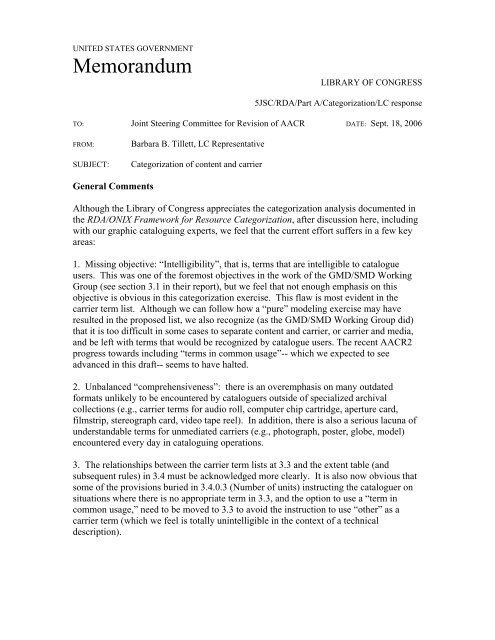
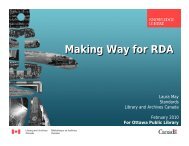
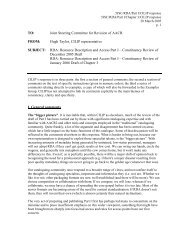
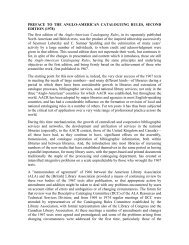
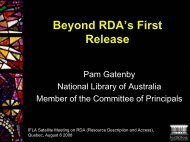

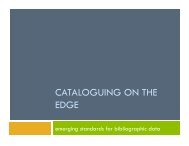

![Presentation slides [PDF] - Joint Steering Committee for ...](https://img.yumpu.com/41621230/1/190x143/presentation-slides-pdf-joint-steering-committee-for-.jpg?quality=85)

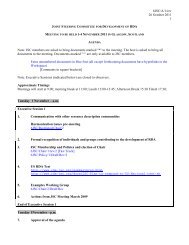
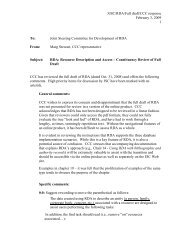
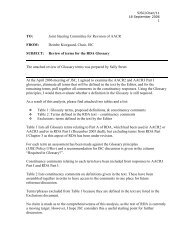
![Presentation slides [PDF] - Joint Steering Committee for ...](https://img.yumpu.com/35256207/1/190x143/presentation-slides-pdf-joint-steering-committee-for-.jpg?quality=85)
